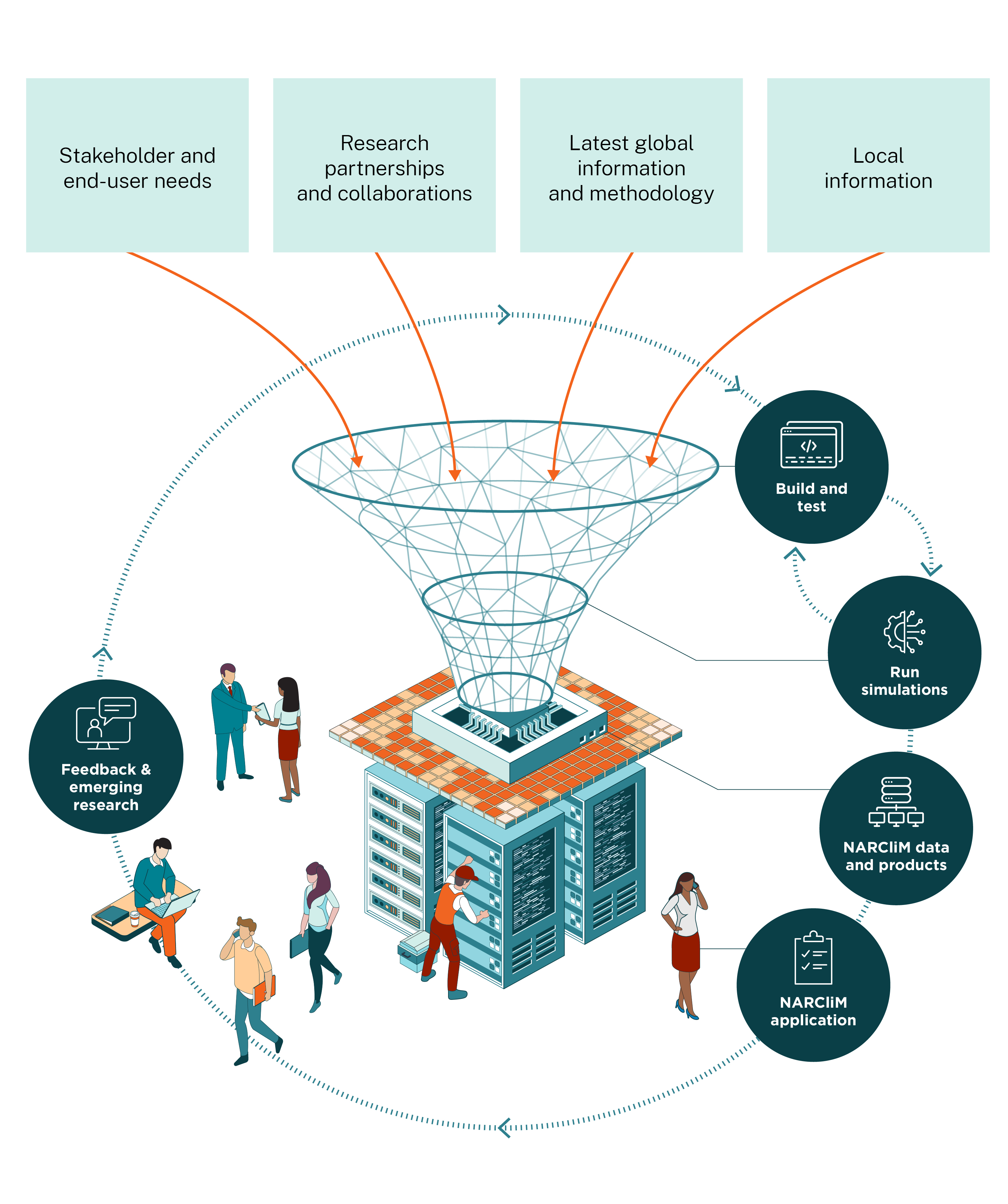Key points
- The NARCliM project combines trusted expertise and processes to ensure that its climate projections reflect future climate as closely as possible.
- Each NARCliM generation is codesigned to ensure that stakeholder and user needs are addressed through the various NARCliM data and products.
- The NARCliM project is an iterative process. It is always evolving, with each generation using the most recent climate information available.
The NARCliM process
Producing NARCliM data is an iterative process. There are 3 generations of NARCliM data available, NARCliM2.0 (2024), NARCliM1.5 (2020) and NARCliM1.0 (2014). Each generation responds to changing end-user needs and incorporates the latest available science.
Each generation of NARCliM is designed and built on the following:
- stakeholder and end-user needs identified through regular consultation
- partnerships and collaborations by engaging research partners and experts
- latest global information and methodology, including emissions scenarios and global climate models (GCMs)
- local information for NSW via optimised regional climate models (RCMs).

Stakeholder and end-user needs
NARCliM projections are designed to be scientifically robust, fit-for-purpose and suited to the needs of end-users and stakeholders.
Each generation of NARCliM is informed by regular consultation with, and feedback from, end-users and stakeholders across various sectors including academia, finance, consultancy, primary resources, industry and government. These stakeholder and end-user needs are captured through several mechanisms such as workshops, codesign webinars and surveys.
NARCliM also considers wider groups who indirectly benefit from NARCliM data, such as community groups, organisations interested in climate change and the NSW public. These stakeholders benefit from the research, plans and policies that are informed by NARCliM regional climate projections.
Partnerships and collaboration
Through strategic partnerships and key collaborations, the NARCliM project brings together scientific expertise in Australia and across the globe to deliver regional climate projections for NSW and the Australian continent. For example, the University of NSW Climate Change Research Centre contributes expertise in modelling to the project. This enabled the launch of the first and second generations of NARCliM data in 2014 and 2020, respectively.
The NARCliM project is also supported by several key partnerships with subnational jurisdictions including the ACT, South Australian, Victorian and West Australian governments. These partnerships provide financial and/or in-kind support, and offer a cross-jurisdictional community of practice to explore the creation of consistent regional climate projections for Australia. Since NARCliM was established, its project team, stakeholders and end-user base have expanded, and new partnerships have formed.
Learn more about research partners and contributors.
Latest global information and methodology
Climate models are continually improving their representation of key processes. To ensure that each new generation of projections adds value and builds on the best available science, NARCliM incorporates:
- a targeted selection of the most recent emissions scenarios and GCMs, which underpin Intergovernmental Panel on Climate Change (IPCC) assessments
- the most recent publicly released version of the regional climate modelling suite.
Local information
NARCliM creates locally relevant climate data for NSW by using RCMs. A complex process is followed to determine the most suitable RCMs that best represent the climate of NSW and Australia. The selected RCMs are paired with the chosen GCMs to simulate the recent past and 21st century climates at various levels of granularity.
Building NARCliM data
Based on the inputs above, NARCliM data are then designed and developed by climate scientists by:
- building and testing models
- running simulations
- refining and delivering NARCliM data and products.
Building and testing models
A large selection of GCMs are evaluated and tested by our climate scientists for their accuracy in simulating the Australian climate, their statistical independence and climate diversity. RCMs are also selected, configured and tested to perform downscaling.
Running simulations
A series of simulations is run using the selected GCM–RCM combinations. This process follows the methodology defined by the World Climate Research Programme (WCRP) Coordinated Regional Downscaling Experiment (CORDEX) as closely as technically feasible.
Refining and delivering NARCliM data and products
All NARCliM outputs undergo a quality assurance process to ensure completeness, reliability and credibility, and to check that any errors have been identified and resolved. Following this extensive review, NARCliM data are uploaded to the NSW Climate Data Portal and made accessible through user-friendly products such as the information published on the AdaptNSW website.
After the data are publicly released, end-users can apply NARCliM to a range of tasks including risk and vulnerability assessments, research, policy and decision-making. As new scientific advancements emerge and additional stakeholder and end-user feedback are received, planning begins for the next generation of NARCliM data.
Iterative climate projections
The iterative nature of NARCliM allows it to incorporate the latest available science and address changing user needs. The 3 generations of NARCliM are each based on the GCMs associated with an IPCC Assessment Report. For example, NARCliM2.0 is based on a selection of GCMs used in the Sixth Assessment Report.
NARCliM development timeline
Each NARCliM generation varies according to the available GCMs, emissions scenarios and RCMs. This – combined with stakeholder consultation, quality assurance and control, and the production time to produce the regional climate model simulations – all influence the development and release time of NARCliM generations.
GCMs take 3 to 5 years to develop and simulate outputs. This means that NARCliM generations are planned and created using the latest GCMs available at the time, but by the time NARCliM data are ready to be published, newer GCMs may be available.
Associated IPCC Assessment Report publicly released | NARCliM project team begin regional climate modelling | NARCliM dataset and information publicly released | |
2005: CMIP3 | 2007: IPCC AR4 | 2011 | 2014: NARCliM1.0 |
2011: CMIP5 | 2013: IPCC AR5 | 2015 | 2020: NARCliM1.5 |
2020: CMIP6 | 2021: IPCC AR6 | 2021 | 2024/25: NARCliM2.0 |
Note there is no CMIP4, and the IPCC Report release year refers to the Working Group I Report only.